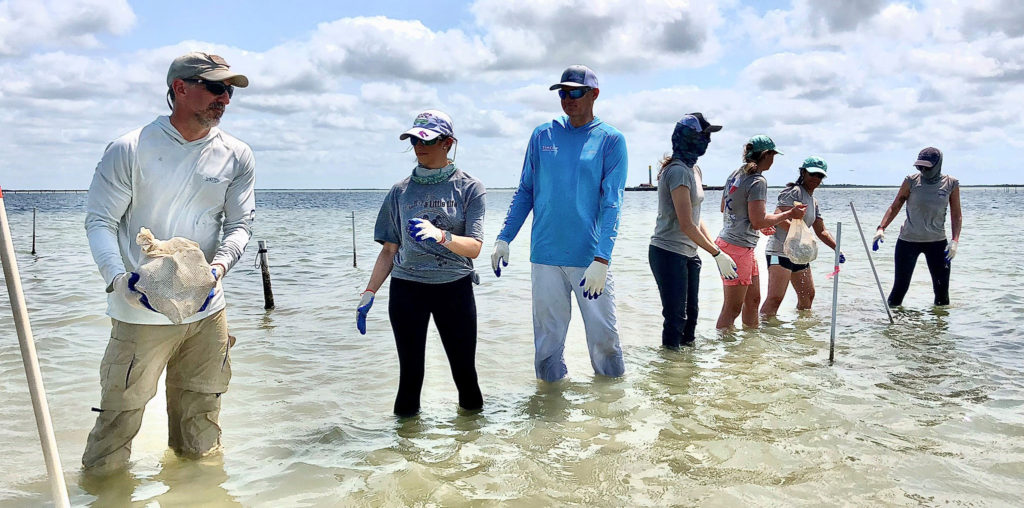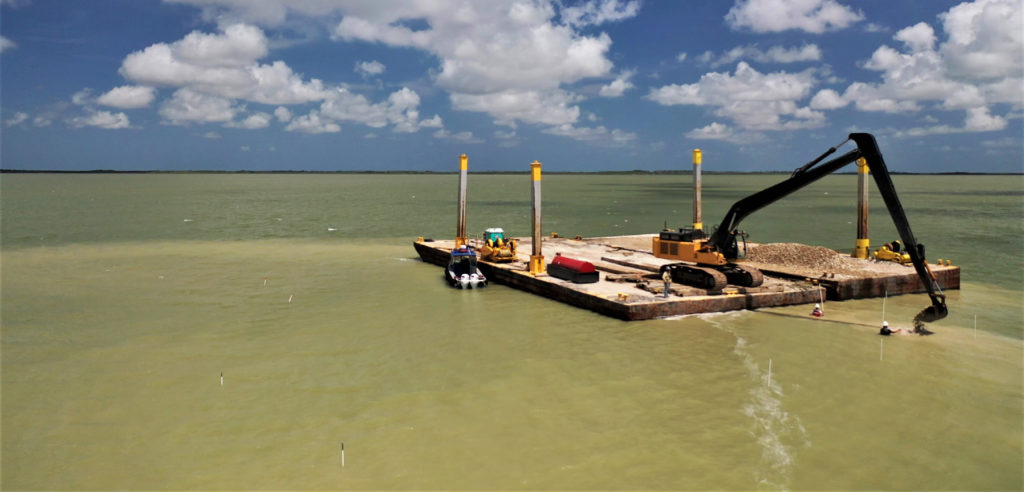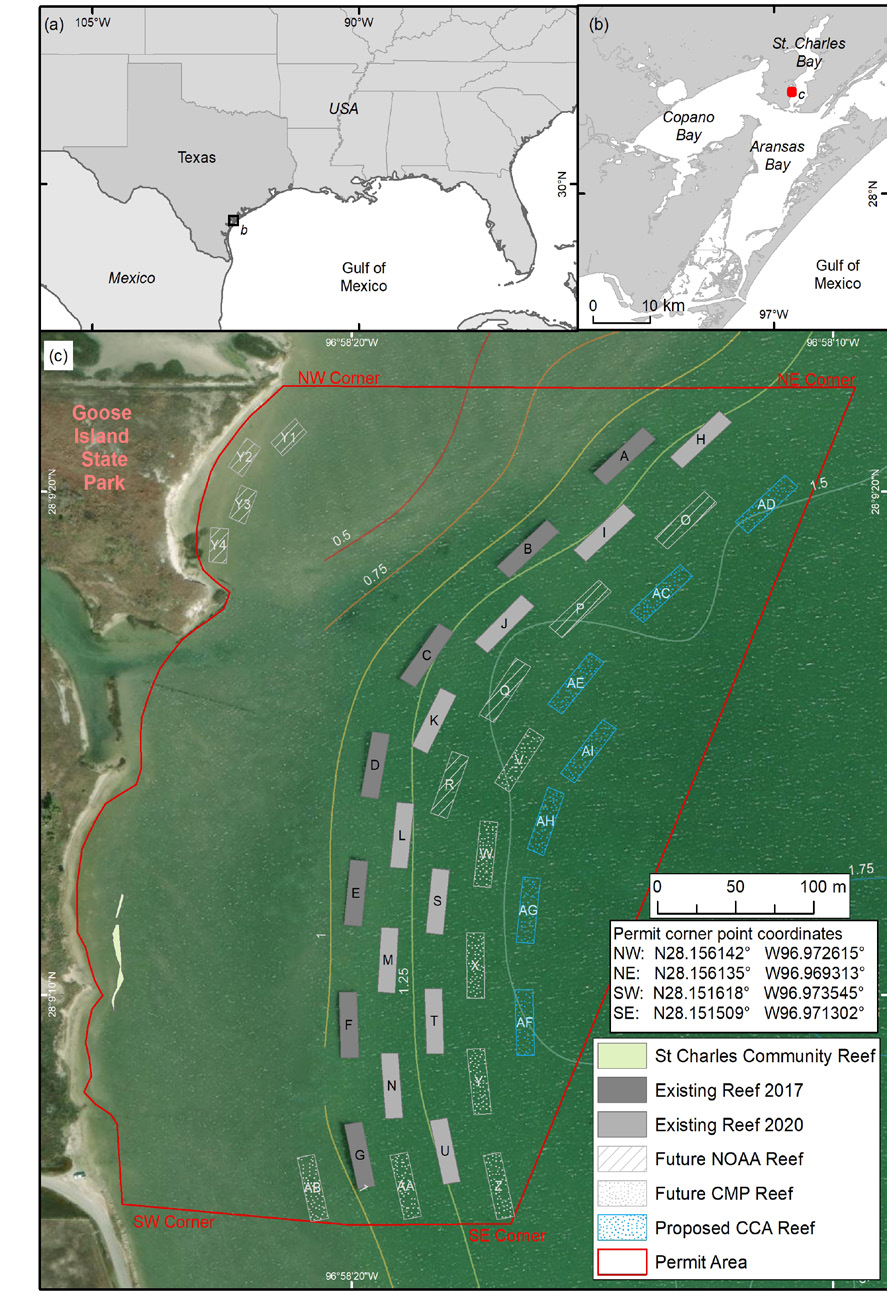
Members of CCA National Staff, Aransas Bay Chapter volunteers, and Yamaha Marine participated in an oyster bagging event hosted by Harte Research Institute. Photo by Pat Murray (@patrickdmurray on Instagram)

InstituteContractors place materials in Phase III of the St. Charles Bay Big Tree Unit Living Shoreline Oyster Restoration Project. Drone photo courtesy of John Blaha.
By John Blaha
Oysters are natural buffers against rising tides and storm surges created by extreme weather. They protect our shorelines and wetlands from erosion. The Goose Island State Park Big Tree Unit is a wintering ground for many species, and most importantly it plays host to the annual winter migration of whooping cranes to the Coastal Bend. The St. Charles Bay Living Shoreline Project was originally born in 2016, and led by Harte Research Institute’s Dr. Jennifer Pollack. The project’s original scope was to create approximately 2,000 feet of oyster reef along the western shoreline of St. Charles Bay to help prevent erosion in this area of wetlands and upland habitat.
Oysters grow vertically into reefs that provide complex, three-dimensional habitats for reef-dependent organisms including small fish and crustaceans. These resident organisms are consumed by juvenile fish and larger crustaceans that use oyster reefs for foraging and predator refuge, and in turn are consumed by economically important sportfish, enhancing recreational fishing in Texas bays. As foundational species, that builds habitats benefiting numerous other organisms, oyster reefs are a priority for conservation and restoration activities. Not only do these types of projects create these eco-system services, they provide important buffers which help prevent and slow down erosion along coastal shorelines.

Phase I of the project was completed in early August of 2017, only weeks before Hurricane Harvey. This phase constructed seven reef beds that measured approximately 120’ long, 30’ wide, and 1’ high. The center of the eye of Hurricane Harvey passed just 4 miles away, creating much concern about the survivability of the new project. Fortunately, the storm had a minimal effect on the project, and the 2017 fall spat set in the area yielded great results on the new reef mounds. The original partners in this effort included Texas A&M University-Corpus Christi, the Harte Research Institute, Texas Parks and Wildlife Department, CCA Texas, U.S. Army Corps of Engineers, and the Texas General Land Office.
With solid success on Phase I, a second phase was planned to add additional reef beds into the area. Phase II was constructed in September of 2020 and added an additional 10 reef beds to the permitted area. Partners in this phase included Texas A&M University-Corpus Christi, Harte Research Institute, CCA Texas, US Army Corps of Engineers, and the Texas General Land Office. CCA Texas contributed $75,000 to this phase, which included $50,000 from Lone Star Breweries and their Hurricane Harvey Relief Fund. The Lone Star Breweries funds were dedicated to habitat restoration in the Coastal Bend area, specifically Rockport and Aransas County.
While the first and second phases were successful, the desire was to work towards filling the entire permitted area. This led to Phase III which was planned and was recently completed in May of 2022. Dr. Pollack and the team at the Harte Research Institute continued to lead the effort. Phase III’s original scope consisted of 15 new reef beds. CCA Texas and Building Conservation Trust once again moved to support the project and did so by contributing $350,000 to expand the project from 15 reef beds to 22. Lone Star Breweries contributed $100,000 and Cheniere Energy contributed $60,000 through the Coastal Bend Bays and Estuaries program to $350,000. Partners in this phase included the Harte Research Institute, Texas A&M Corpus Christi, CCA Texas, Building Conservation Trust, Lone Star Breweries, Cheniere Energy, the Coastal Bend Bays and Estuaries Program, NOAA and the Texas General Land Office.
Long-term success of the reef will continue to depend upon larval oyster settlement onto the reef structure and survival and growth of these oysters to larger size classes. Dr. Pollack and her staff of graduate students and research associates continue to conduct seasonal monitoring to measure structural and functional characteristics of the restored oyster reefs. Nearby reference locations on existing oyster reefs are used for comparison purposes to measure the success of these projects. In addition to the monitoring program, Dr. Pollack and staff host hands-on oyster bagging events. These events present a hands-on opportunity for participants to hear from researchers and graduate students about oyster reef ecology, and why reef restoration is important. Hands-on work is done by bagging recycled shell collected from partner area restaurants and placing it back into the bay to create new reef structure. At the end of May, representatives from Yamaha Outboards, CCA National staff, and Aransas Bay CCA volunteers participated in a bagging event. This event gave participants the opportunity to gather a deeper understanding of the ecology and benefits of this important habitat. CCA Texas, the Building Conservation Trust and partners are proud to be a part of these projects and are committed to these efforts to ensure healthy oyster reefs and eco-systems for present and future generations.





